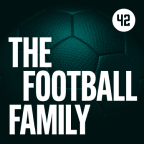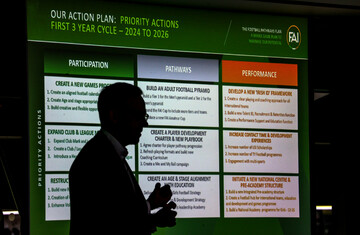MARC CANHAM IS at pains to point out that an aligned calendar for all levels of football in Ireland is not the only part of the FAI’s football pathways plan, but it’s certainly its most symbolic.
The pathways plan is an overall blueprint for the sport in Ireland that first highlights its biggest problem: it is gapped, discontinuous, inconsistent, fragmented.
Different counties and leagues run different seasons, with the country beset by a mixed application of the formats requested by the FAI under the plan of Canham’s predecessor Ruud Dokter.
Only Cork and Dublin operate at all levels of the game: youth, junior, intermediate, and League of Ireland, and that’s only for the men’s game. Not a single county in Ireland offers all of these levels to girls.
There are some counties in which kids are playing football only 30 weeks a year, which is down to poor facilities that are quickly made unplayable in winter weather.
Different strands of the game running different calendars is not normal – Ireland is the only country in Europe currently doing so.
So the vision to have the underage grassroots and adult amateur game align with the League of Ireland and play in a single, calendar year is an overarching one to unite the game in Ireland. This would in turn allow the FAI to build a football pyramid, in which it would be theoretically possible for an amateur side rise to LOI status by virtue solely of their results on the pitch.
Following publication of the pathways plan in February, the proposed calendar season was met with some vociferous criticism. The Carlow and District Soccer League took it upon themselves at their subsequent AGM to vote against any future calendar season, saying they want to continue to run from September to May and they hope the FAI board will respect that wish.
Canham and the FAI have been meeting affiliates in recent months to talk through the calendar proposals, and how the plans could look in their respective leagues. He says the opposition is beginning to soften.
“From when we first launched the plan there is definitely a different conversation happening now to what it was then”, Canham told reporters at a briefing yesterday.
“There are still some really strong voices that are really against these proposals. I would say in the meetings we’ve had with [with provincial FAs] there is now a strong pool of voices for this as well; a more than mixed blend I would say.
“Reverse back four or five months and there was definitely a strong position that ‘we don’t want to do this.’ It has definitely become more mixed and there are more voices saying that this can be good and ‘I understand this a bit more now, and understand what you are trying to achieve.’”
The FAI aim to have the aligned calendar in place from the start of 2026.
While Canham admits that there remains opposition to this alignment, it has significant backers: the whole of the FAI board have endorsed the pathways plan, and thus the alignment within it. The full document is prefaced by a message from FAI president Paul Cooke, who wrote he “fully endorses” the plan.
A staging post for the strength of that support will be at a board meeting at the end of October.
“The idea will be to go to the board next month and present all the feedback from the game, specifically on what the calendar and children’s games programme will look like”, said Canham.
Canham’s next sentence may have contained some unfortunate Freudian foreshadowing.
“Then we’ll collectively agree a different way forward – sorry, not a different way – a way forward”, he said.
Whatever the precise details of what is presented, were the FAI board to opt against the principle of an aligned calendar months after endorsing a document which presented that very principle would bring scrutiny upon board members, rather than Canham.
The board only weeks ago bestowed upon Canham a new title of chief football officer.
Through this prism, next month’s board meeting will be a measure of the FAI’s own appetite to tackle the problems in elite player development that have become so painfully evident in the senior men’s team’s on-pitch struggles across the last few years.
The pathways plan contains a few other specifics aimed at elite player development, with the decision made to discontinue the Emerging Talent Programme, which provided additional contact hours for talented teenagers from eight centres across the country.
Canham says contact time for highly-rated prospects in Ireland needs to be trebled, and professional LOI academies will be expected to do this work. They remain starved of funding, though the FAI hope to have clarity by the end of the year as to how much of their requested €10 million will be granted by the government. Canham cited highly-developed football nations like Spain, Germany, and France who have effectively outsourced the development of players aged between 14 and 18 to club academies, from where those players train for between 40 and 50 days in the international programme.
The FAI want to get to this point, but admit in the medium-term that they will need to provide some level of elite coaching from Abbotstown to complement what is being done at clubs. They are currently working on what this offering will look like.
That offering will likely be influenced by “the green line”, the title Canham has slapped on the FAI’s vision of the style of football all Irish international teams should play. It’s envisaged that this style should be so obvious to the public that an Irish team could be identifiable even without wearing Irish shirts, and it will be developed by a “technical leadership group”.
Canham will be in this group, along with senior managers Heimir Hallgrimsson and Eileen Gleeson, plus U21s boss Jim Crawford, head of women’s football Hannah Dingley, board member Packie Bonner, grassroots director Ger McDermott, and Canham’s assistant Shane Robinson.
Future head coaches will be recruited on the basis of this style of play, but neither Hallgrimsson and Gleeson will be obligated to immediately enforce it among their teams.
“Heimir and Eileen’s job is to maximise the talent pol we got at the moment”, said Canham. “In time, hopefully they are in situ for a long time, and we start to see that development come through. But their job is absolutely around performance and getting results.”
Elsewhere, the FAI will soon send out expressions of interest to clubs interested in joining a new LOI third tier, which they hope to get up and running in 2026. The ambition is to build two regional divisons of 10 teams each as the pinnacle of amateur football. Canham was taking nothing off the table as regards which teams would be eligible, throwing open the prospect of the league featuring LOI reserve teams, college teams, and schoolboy clubs.
Canham also preached patience: he cited the England team that recently steamrolled Ireland at the Aviva Stadium and pointed out that seven of that starting XI were in primary school when England massively overhauled their player development plans in the wake of the failure to qualify for Euro 2008.
While the fruition of the plan is undoubtedly a long-term thing, a crucial early staging post is fast approaching.











I rarely agree with dubs but I agree with him. It’ll make the game too stop start, and kill any momentum. Hopefully teams don’t start hoofing long balls now, and they try and play good football like Dublin/mayo/cork/kerry
@Cortiss: be good to see Cork sticking their chest out again
@Cortiss: Cork?!?!?! Strange one
@Cortiss: sure you love a long ball yourself
@Jamie Bent: they play great attacking football, still nowhere near the top teams but I admire their style. Admittedly I am a cork man
@Cortiss: they put in a great display against Dublin in the super 8’s
@Cortiss: what momentum? Most games are full of lateral and backward handpassing at walking pace with occasional bursts of pace. Football coaches caused this rule change. The biggest problem football faces is football people. You ruined your own game, spend all the time bitching about that but are unwilling to do anything about it. Change the record.
@Cortiss: he’s 100% right .. what will happen it clever teams will play clever little pass, just on the limit of the distance, straight into the chest of an attacker running away from goal! Players like Mannion have the pace to get out a step ahead of their marker, sprint out of from the goal to receive a basic kick pass to the chest… he then ridiculously gets rewarded with a free shot instead of having to deal with the defender who’s now breathing down his neck. Before the new rule he may have been dispossessed by defender or had a shot or pass blocked but now the game will stop. The only way to tweak rule to stop this is to insist the ball is caught above the head
@Cortiss: sorry for your troubles (been from Cork I mean)
Why on earth would the dubs want anything to change? Plus when they did play with the mark last year they were badly exposed by it. And you’ll hit me with the ‘oh but sure they didn’t work on it I training’ but if it’s such a basic skill like mannion said then surely defending it is a basic skill also?
@Mel Roberts: do you honestly think the mark will change the way Mannion or Con play Mel? They field the ball and run at defences with it
@my name: in fairness I think he’s saying they’re team will suffer not that it’ll force mannion to change the way he plays
@my name: I’m not talking about how they will play. I’m talking about how exposed your full back line was when they came up against teams who could use the mark to their advantage. It’s your full back line that would need to change the way they play
@Mel Roberts: something along these lines?
https://www.sportsjoe.ie/gaa/brian-howard-175554
@my name: was that against the mark? Eh no. Does Brian Howard play in the full back line eh no. I’m talking about against the mark last year they looked exposed. Why bring something irrelevant into it?
@Mel Roberts: was Brian Howard playing in the full back line? Was the ball delivered to a target man on the square? See the similarities there? I can’t make it any easier for you buddy. The ball was defended on the full back line
@my name: mate have a read at my initial comment. When Dublin full back line have played against the mark they have been exposed. You be gave one example of a fella who’s not a back making a catch which wasn’t against the mark as it wasn’t in use then
@Mel Roberts: what position was Murchan playing in that game or jack mccaffery in the drawn game? Dublin players don’t play the number on their back is the point I’m making here Mel. Like you said, last season they didn’t train for the mark. They probably won’t have time before the league kicks off this year as they’ve been away. They’ll use the league as training for the championship. You’re a football man, thought you’d see that
Sorry my reference for Murchan was this goal
https://youtu.be/2mheijU7QIM
@my name: But sure if catching a ball is such a basic skill like mannion has said it is why couldn’t Dublin defenders do it against the mark last year?
@my name: why are you throwing up games where there’s no mark? Read what I have said, against the mark they were exposed which they were. You’ve gave 2 examples where there’s no mark?
@Mel Roberts: I’ve made it as simple as I can for you pal but no you just want to sling mud. You’re the very man who posts on here constantly saying everyone’s against you and Tyrone. Yet every chance you get you’re at Dublin no matter the subject, you actually compared yourself to James McClean the other day too. I give up, you bring it on yourself and then have a wee cry about it
@my name: I mean why are you posting from games where there is no mark to make a point that Dublin can defend the mark? That’s all I’ve asked? I’ve no slung any mud
@my name: btw I never compared myself to James mcclean. I said that you are all happy to jump on the bandwagon when he’s getting abuse but at the same time agree with someone labelling all northerners as brits
@Mel Roberts: badly exposed by the mark last year? When the facts are that Dublin had the best points difference (+23) in the league last year
@my name: Teams that utilised the mark exposed them, Tyrone tore them apart as did monaghan and showed that they were vulnerable against it
@Mel Roberts: Tyrone tore into Paddy Andrews and left marks alright. Come the business end of the season Mel, you know full well Dublin aren’t getting torn apart by Tyrone
@my name: I never said they were? If there’s a way to get at Dublin that’s it though. As for paddy Andrews an accidental collision? Really still going on about that
@Mel Roberts: the Dubs were exposed by the mark the last time because they knew it wasn’t being used in the championship and so they rightly completely ignored it in training… planning instead for the C’ship without it!! Be under no illusion Dubs will exploit this as well as everyone and better than most now that it’s in. It’s a terrible rule that will lead to attackers running away from goal to receive easy passes to the check and be rewarded with a free shot
@my name: he won’t have to run at defences… all he’ll have to do is run out from goal 1 step ahead of his marker and receive a basic pass into the check. He’ll then have 15secs for easy free. What people need to ask themselves is “what’s the worst way this new mark could be exploited?” “What way can it be exploited that goes against the spirit of what it is intended for” – And that’s exactly how it will be used!!
@Meatloaf: i disagree – I think he’s looking forward to kicking easy frees for fun without having to beat his marker other than getting 1 step ahead of him as he runs away from goal to receive a basic pass into the chest… of this is what happens it will be awful
Most full back lines look vulnerable under a high ball. In my view it will make the game more defensive
@John O Reilly: everyone is assuming it will be exploited via a ‘high ball’… when in my view 90% of the scores will come from attackers sprinting away from goal to receive an easy kick pass into their chest
15 seconds for a forward to play the ball once a mark is called. Totally unrealistic in terms of what the y get normally. Every attack should end in a score. Expect more fouling up the field and more packed defenses
@JPM: Thats a very intelligent comment, I agree completely with the point you make about realistic game play. Hurling has become so much more popular at least in terms of watching the sport as its continously about attack and flow of the game. I suppose if I was to make a point about the mark, even though its available to an attacking team, it doesnt necessarily mean they will use it. A more important issue might be that this rule will add further pressure onto referees.
Why are we forever tinkering with the rules of our game? We have the greatest sport in the world, just leave it be. I don’t see fifa introducing 4 or 5 new rule changes every year
@The Analyst: no, just one massive one…. VAR!
I’m sure we will see Tyrone kicking penetrating long passes as they surge forward
@John O Reilly: you mean just like they did all last year? Have you actually ever watched Tyrone play or does your hatred just stem from all things north of the border?
@Mel Roberts: how do you feel about Mickey Harte
@Mel Roberts: I just dislike sledging. I think it’s disgusting
@John O Reilly: is this an article about Mickey harte? Why not answer my question instead of throwing up that nonsense
@Mel Roberts: I did
@John O Reilly: give me an example of Mickey harte sledging? Are Tyrone the only team that does it? Ever played against Tyrone to know?
@Mel Roberts: I never said Mickey Harte sledged anyone. but tyrone players did. I asked your view about Mickey Harte as a manager
@John O Reilly: He’s one of the greatest managers the game has ever seen in my opinion and the opinion of many
@Mel Roberts: should he stay on
@John O Reilly: This year yes
@Mel Roberts: after this… if they don’t win recall ireland
@John O Reilly: No and I think he will go himself and it’s well known who his replacement will be
@Mel Roberts: who?
@John O Reilly: Mel Roberts!
@John O Reilly: Malachy o Rourke according to people in the know
@Joe Kennedy:
@Joe Kennedy: taking the minors this year joe
@Mel Roberts: haha….Fair play.
Just as the tied against packed defences had turned congress steps up and potentially shoves us straight down that road all over again. Jesus wept
hi
my hot photos are here …
http://69-chat.club
only 18+